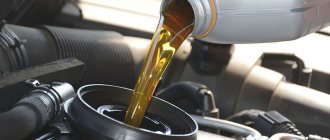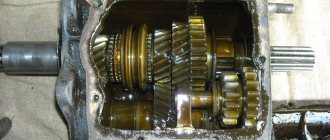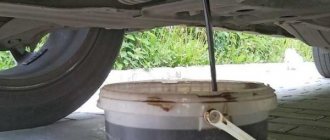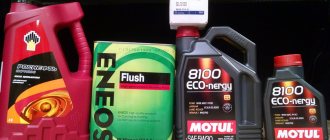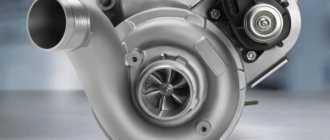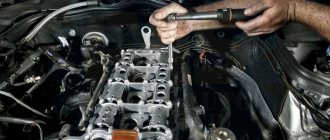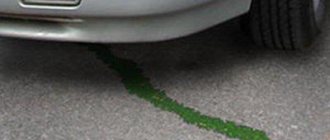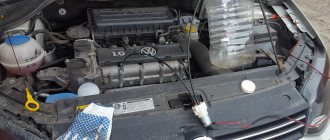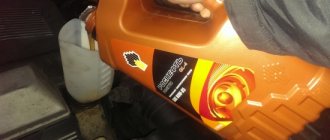Why and why engine oil leaks from under the oil filter after replacing it
Incorrect installation of the filter element
The main reason for oil leakage from under the oil filter on a new engine is failure to comply with the torque limit requirements. The lubricant is pressed both when under-tightening and when over-tightening. In the first case, the rubber simply does not fulfill the task of sealing, since it is not clamped between the ends; in the second, its shape is deformed or the rubber product completely breaks.
Initially, they start from a less critical point of view: it is assumed that the filter element is not tightened enough. A component that is clamped to capacity will not rotate, but a component that is not tightened will make an extra 1/2-3/4 of a turn, which is sometimes quite enough. Among the icons on the side panel of the filter, another one is important; it requires you to lubricate its rubber ring with oil before installing the cleaning module. New or old - it doesn’t matter, the fact that the oil composition is located on the outer end of the seal is significant:
- The lubricant prevents the rubber product from cracking when tightened tightly.
- The viscous layer promotes a tight fit of the ring to the mating end on the cylinder block.
- A layer of emulsion between the rubber and metal prevents the ring from sticking to the engine body.
Low quality filter
Poor quality paper or a defective bypass valve in the purifier body creates noticeable resistance to the flow of oil, and it begins to look for alternative ways to exit the defective component. General advice is to ignore products from little-known manufacturers that have an affordable price, and beware of counterfeits of well-known brands.
Exceeding the recommended amount of lubricant in the engine crankcase
At a level above MAX, it is clear why oil leaks from under the engine oil filter. Due to the increase in pressure, even a small overflow of oil into the engine leads to squeezing it out through all kinds of oil seals. There is only one recommendation - to bleed off the excess volume as soon as possible.
Unsuitable oil
The optimal viscosity of the oil emulsion is calculated based on many factors, the main ones being the clearances in the cylinder-piston group and the ambient temperature. What the engineers calculated is displayed in the operating book in the form of a list of recommended viscosity characteristics of the composition.
Deviation in favor of unspecified viscous or liquid categories leads to leakage at the points where the sealing elements are attached. Choosing without taking into account the average winter temperature is also illiterate - in the cold the lubricant thickens and may not pass through the filter. In the event of a strong difference in summer and winter temperatures, it is useful to know how to heat the oil in the crankcase of a car engine.
Complying with the instructions is a surefire way to properly operate a car, but no one is safe from counterfeits. Fake lubricant can be squeezed out and the only way to identify the cause is to understand the differences between the canisters of the original and the “basement” product.
How to detect a leak
How can you tell if there is oil leaking from the engine? One of the signs of a leak is a slipping clutch. If car oil ends up on the intake manifold or exhaust pipe, you will notice unpleasant odors and notice bluish smoke coming from the engine compartment.
Look at the place where your car was parked. Grease spots under the engine clearly indicate an oil leak from the engine. Also pay attention to the oil level sensor, which is located on the dashboard. Look at it every time before starting the power unit.
For what reasons do leaks appear and the oil level decreases?
- The intake manifold control system has broken down.
- Leaky lubricant quantity indicator.
- Leaking oil filter.
- Leaking engine seals.
- Pouring inappropriate motor oil into the lubricant complex. It happens that the driver ignores the car manufacturer’s advice regarding the selection of lubricant. Why shouldn't you do this? The properties of a particular consumable depend on the additives, chemical composition, and viscosity index. The components of an unsuitable lubricant can damage the rubber parts of the intake system. Because of this, oil leakage may occur between the engine and gearbox.
- Exceeding the volume of petroleum product poured into a gasoline/diesel engine. If you pour too much oil into the internal combustion engine, this can cause an increase in compression. Consequently, the load on seals and seals will increase, and they may collapse.
- Long-term non-use of the car. If the engine does not warm up for 20 days, the lubricant will leak into the crankcase pan. Seals and seals will dry out.
- Poor crankcase ventilation. Every driver knows where the exhaust enters the crankcase: from the piston system. If the engine is worn out, the piston holes allow a lot of gas to pass through. When they accumulate in the crankcase, increased compression is established in the unit. The ventilation system should reduce it. However, if the channels are clogged, compression will not decrease. The consumable will be squeezed out of the lubricant complex.
- Damage to the cylinder head lining. This seal can be damaged anywhere, causing an oil leak in the engine. Lubricant will enter the cooling system if the area near the cylinders is damaged. A leak can be determined by the cloudy color of the coolant. The car will also lose power, the antifreeze will foam, and the engine will overheat.
Possible causes of fresh oil leaking from under the oil filter in the periods between its replacements
A healthy approach to changing lubricant involves deviating from the standard advice to change the composition every 15 thousand km. Naturally, in the direction of reducing the interval, and by a factor of two. Those who don’t do this often put up with a dirty filter element, from under which the emulsion is crushed.
Bypass valve
Any paper has the right to lose capacity. In this situation, a bypass valve provided in the engine or filter housing, which allows lubricant to flow into the engine without filtration, helps eliminate oil starvation. Build-up or aggressive flushing can exhaust the bypass system, slowing down or stopping its operation altogether. If the oil pressure light comes on and at the same time oil leaks are detected under the filter element, there is only one verdict - change the filter and clean/install a new bypass valve (if it is located separately from the purifier).
Let's sum it up
We can talk for a long time about how exactly a car is diagnosed and repaired. But it’s better not to wait a second if you notice really dangerous symptoms with your vehicle. The best solution in this case would be to perform a high-quality inspection yourself right on the spot where you first noticed the unpleasant moment. If you do not find a leak, you should immediately contact a specialist. If you are not sure about the safety of a particular problem, it is better for you to seek the help of specialists as quickly as possible.
Also, you should not experiment in this situation. It is necessary to determine exactly where the oil is oozing from in order to simply remove it. It is also worth preventing possible problems of the main units. To do this, you need to check the oil level in them constantly, use a variety of tools to obtain information about what exactly is wrong in your car. This will help you correct the situation and repair the problem without much difficulty. But you shouldn’t drive a car for a long time with oil leaking from under it. It's better to go straight to the service station. Have you ever had a situation where technical fluids leaked from under your car?
Related questions
A leak at the point where the filter is connected to the cylinder block occurs due to loss of throughput, excess inlet pressure, or a simple lack of quality contact between the rubber seal and the metal. By the way, the latter can happen due to a break in the thread on the fitting, which makes it impossible to tighten the component tightly.
Will oil leak if you unscrew the oil filter?
Lubricant will undoubtedly leak from the filter element. Due to the presence of shut-off valves, after completion of work the oil filter housing is filled with a lubricant in order to prevent oil starvation the next time the engine is started. When working on a cold engine, you will lose a minimum of volume:
- The liquid drains from the cylinder head into the crankcase within half an hour.
- The pan is always located below the purifier and the situation cannot change the laws of physics.
- Only what remains in the filter element housing will leak out + from the nearest oil channels.
How to distinguish a fake filter from the original
The general recommendation is to pay attention to the details of the markings and design of the case. Detailed differences between a non-certified product and the original are contained on the official websites of dealer companies. Another option is to take it from trusted places.
Preparing to find a possible oil leak
Firstly and initially, before you start looking for an oil leak, you must clean the surface of the engine itself from dirt and dust. This will make it easier for you to locate the greasy stains left by motor oil or other vehicle fluids.
To clean the engine from dust and dirt, you can buy a special cleaner at a car store and wash the power unit of the car yourself. You can also pressure wash your car engine at a car wash.
This is interesting: Extended car warranty: An expensive gamble
Please note that cleaning the engine using a special cleaning spray manually or in a car wash should only be done with a cold engine. In the process of washing the engine, you must also clean not only the power unit itself, but also all hoses, brackets, the engine pan, and at the same time wash the bottom of the car and its suspension.
Attention! When cleaning the engine, you should be sure to protect all electrical connectors and exposed terminals on the machine with sealant material. Otherwise, you simply risk accelerating the corrosion of the car’s electrical components or simply not starting the engine after such a wash.
Summary
Diagnostics and recommendations on what exactly to do will help you find out why oil is leaking from under a newly installed oil filter:
- Does the lubricant level in the engine crankcase exceed the MAX mark on the dipstick? If yes, remove some of the liquid.
- Is the wiper housing tightly pulled to the cylinder block? No - tighten it 1/2-3/4 turn.
- Is the thread broken? Yes - the steps depend on the specific car: install a longer stud, install a new tip, cut a new one...
- Is the correct oil filled? No - replace the emulsion.
- Is the filter part too tight? If yes, it will not twist when significant force is applied. Unscrew the filter element and look at the seal - deformation and cracks are not allowed, otherwise only replacement.
- Is the component original and of high quality? No - replace.
If there is pressure on the lubricant and the oil pressure lamp is on, the filter is dirty and the bypass valve is clogged. On cars with an impressive mileage, the cause of the leak may be a faulty pressure relief valve. Both problems often manifest themselves during the interregulatory period.
During the operation of the car, a situation may arise when oil is squeezed out through the oil filter; the reason for this phenomenon can be quite different. As a result, regardless of the reason, a significant amount of lubricant is lost, and the operation of the power unit can be greatly complicated. Therefore, as soon as such a problem is discovered, it is necessary to stop the car as quickly as possible and take all measures to eliminate this problem.
Oil leakage from the engine - causes and solutions
An engine fluid leak can occur on absolutely any engine. The gist of this is that there are many different seals in an engine that can become damaged due to use. As a result, the unit will leak over time and the car owner will be faced with the problem of why the oil is leaking and what to do about it.
The main reasons for this problem
For experienced motorists with extensive driving experience, a situation where oil has been squeezed out through the oil filter may be due to the following:
- serious malfunction of the valve itself;
- large discrepancy between the viscosity of the lubricant and the characteristics of the power unit;
- weak fixation of the filter itself on the surface of the fitting;
- severe contamination of the filter surface, which made it difficult for the lubricant to pass through the filter paper;
- use of low-quality polymer-type sealant.
List of main conditions causing oil filter leakage
- A very common reason is the squeezing out of the lubricant when starting the unit in winter. Under such conditions, the oil that has thickened in the cold is not capable of leaking through the membrane layers due to its structure. As a result, a jelly-like lubricant under strong pressure breaks through the layers of the membrane and flows out at the base through the thread channels.
- Incorrect operation of the oil pump, which at high speeds creates excess pressure, which can squeeze oil through all possible leaky areas. Very often the oil filter is the weakest point.
- In the case of using a brand of oils with increased oil viscosity in severe frost conditions. Such a mistake can occur either due to the inexperience of a novice motorist or as a result of purchasing a counterfeit product.
Features of the disease in men and women
Pregnancy, childbirth, menopause and the structure of the female urinary tract are reasons why involuntary leakage is more common in women.
Diseases such as diabetes, Parkinson's disease, and multiple sclerosis (MS) can damage the nerves that control the bladder. Urinary tract diseases, infections, strokes, surgery and treatment for pelvic cancer can also cause problems that are directly related to uncontrolled incontinence.
In addition, other common causes of the disease are:
- tumors or other obstructions;
- poor kidney function;
- use of certain medications;
- consumption of certain foods and drinks;
- drinking a lot of liquid per day, which is why the bladder cannot cope with retention.
Stress incontinence is common among women, especially those who have given birth vaginally. Caused by coughing, sneezing, laughing, bending or lifting. These triggers can cause urine leakage after childbirth.
Extreme urine leakage in the elderly is common in both men and women. Characterized by increased urinary urgency (overactive bladder), uncontrolled urine flow, and increased frequency of urination.
Overflow incontinence, which results in leakage when coughing, extremely frequent urination, and an inability to completely empty the bladder, is called dribbling. This pathology often occurs in women who have just given birth and whose muscle tone has not yet been restored.
Functional disease occurs in both women and men. It is most common among older people and those who suffer from diseases such as Alzheimer's or Parkinson's disease. Urine leakage in men is possible due to an enlarged prostate.
Mixed urine leakage during pregnancy in the second or third trimester occurs as a result of a combination of the symptoms described above. In men, a common cause of the disease is nerve damage and prostate problems.
How to eliminate lubricant leakage through the filter
If the oil has been squeezed out through the oil filter and the cause has already been found, then you need to start eliminating the leak. To carry out repair work, you need to prepare a set of keys and some rags.
The entire repair process consists of the following activities:
- using keys, remove the timing belt cover;
- the auto valve plug is unscrewed;
- the spring is carefully removed;
- the valve is removed and checked for scoring or other types of mechanical damage;
How to choose a quality filter
Very often, oil leakage can occur due to the use of a low-quality filter.
In order not to buy a low-quality counterfeit, you must remember the following:
- When purchasing an oil filter, you should pay attention to the condition of the packaging. If there are signs of deformation and there are large holes in the case, then this is a sure sign of counterfeit.
- It is necessary to study the technical condition of the polymer sealing ring and the filter membrane. The height of the sealing ring should not be more than 0.8 mm. above the surface of the lid. A high-quality membrane should be free of irregularities and of the same color.
- You need to buy a filter only in certified auto stores that have official registration and a long period of operation.
- You should not chase cheap filters, since very often low-quality material is used for their manufacture, and they have a limited service life. By applying the above recommendations in practice, you can minimize the likelihood of purchasing a filter with low technical characteristics.
Signs of Oil Loss
Oil leaks from the engine occur for various reasons. Therefore, signs of loss of lubricant also manifest themselves in different ways.
The most common sign that immediately shows that there is a malfunction in the car is an oil slick in the area of the engine crankcase. It usually appears when the car is parked for a long time. That is why experienced motorists inspect the space under the bottom every morning, between the front wheels of the car. Even if a stain or a small puddle appears, it is not a fact that the engine is leaking. The leak sometimes occurs from the gearbox; there is also gear oil there.
The second main sign is a drop in the oil level, which can be seen on the dipstick. To do this, stop the car on level ground and wait 10–15 minutes for all the lubricant to flow into the engine crankcase. Having removed the dipstick, wipe it well with a rag, then reinsert it into the neck until it stops. If the lubricant level has dropped, you need to immediately find out the reason. It seems that there are no oil stains or smudges, but the lubricant is leaving. The fact is that motor fluid can not only leak, but also burn out while the engine is running. If you place the vehicle on an inspection hole, or drive onto an overpass, a visual inspection will help localize the problem.
Other causes of gearbox oil leaks
In addition to oil seals, there are other common gearbox malfunctions that cause transmission fluid leaks. For example, if oil flows from the joint of the box body, the unit must be removed and disassembled. The surfaces at the joints should be cleaned of old sealant and then degreased. During reassembly, sealant is applied to threaded connections and other elements.
Also, as mentioned above, the diameter of the shafts often decreases in the place where the shaft contacts the oil seal. As a result, oil leaks from the gearbox appear in this place. To fix this problem, it is necessary to install a new cuff, and the new oil seal is not pressed in completely.
This makes it possible to ensure that the unworn part of the shaft begins to contact the working edges of the oil seal, that is, the necessary seal is created. However, it is important to take into account when pressing the oil seal in such an incomplete manner that the oil seal should not be skewed. In order to avoid distortion, experts recommend using spacers, the thickness of which is about a millimeter.
We also add that the internal cavity of the box must communicate with the atmosphere. For such a message, an element better known as a breather is used. So, if the breather is clogged, as a result of heating the oil, the air inside the gearbox does not come out and begins to create excess pressure. This often causes the oil to “press” through the oil seals and oil seals. It is also possible that the cuffs are simply squeezed out of their installation locations.
As for automatic transmissions, cars with such a gearbox usually have an additional circuit for cooling the automatic transmission oil. The automatic transmission oil passes through the additional radiator and then returns to the box. Often road reagents destroy the automatic transmission radiator fittings at the junction with the oil supply pipes. In such a situation, you can either change the radiator and/or pipes, or weld new fittings to the old radiator.
In cases where oil leaks from the gearbox on a new car, that is, the gearbox has practically no mileage, there is a high probability of defects and damage to the crankcase or rear gearbox cover. Cracks may be a manufacturing defect that occurred during the casting of parts.
We also recommend reading the article on how to change the oil in a manual transmission. From this article you will learn about the features of changing oil in a manual transmission, as well as what nuances you should pay attention to.
Another crack in the gearbox housing may be the result of a serious breakdown of the gearbox itself. For example, if a tooth on one of the rings breaks off, the rear cover/gearbox housing is also damaged. As a rule, in such a situation, the oil leak is very strong, the lubricant quickly flows out of the cavities of the box. In this case, the unit must be defective, after which either the gearbox housing and damaged elements are replaced, or a contract unit is installed.
Causes of leaks
In order to fix the problem, you need to find out why the oil is leaking. The reasons may be different:
- Defective gaskets or seals. There are a lot of them in the engine - in the area of the gas distribution mechanism (GRM), cylinder head (cylinder head), oil filter, crankshaft, as well as other components of the power plant.
- Malfunction of the crankcase ventilation system. While the engine is running, some of the exhaust gases break through the oil scraper and compression rings into the crankcase. They create excess pressure on the engine oil. Thus, the lubricant can be squeezed out through the seals or gaskets, because some of them may not withstand such pressure.
- Poor quality oil fluid. Counterfeit motor fluid is often sold on the market under the guise of original fluid. It is quite difficult to recognize it, so car enthusiasts, especially inexperienced ones, often buy fakes. The operation of the engine leads to an increase in temperature to 250–300°C in the area of the cylinder-piston group. The counterfeit product loses its viscosity and liquefies. In this state, it leaks through the seals in large quantities. The same applies to waste - flowing through the piston rings, such “oil” burns along with the fuel. Fumes are indicated by the bluish color of the exhaust gases escaping from the exhaust pipe.
- Finally, the most common reason is damage to the oil pan during a trip. Sometimes objects come across under the bottom that can seriously damage the pallet. That's why some automakers, as well as many car owners, install additional protection on the crankcase.
Causes of oil leaks
To understand how to fix an oil leak, you need to find out what the source of the problem is:
- oil sensor is leaking
- the front or rear crankshaft oil seal is leaking,
- oil leak from under the valve cover,
- the ignition distributor is leaking,
- oil filter is leaking,
- crankcase ventilation problems,
- Too much oil is added or it does not comply with the manufacturer’s recommendations,
- damaged oil pan,
- low quality motor oil.
Let's look at each reason in more detail.
Oil sensor leaking
If oil leaks from this device, it may seem that the problem is in one of the cylinder head seals. You need to carefully inspect the motor to understand that it is the sensor that is faulty. The problem is resolved by replacing the sensor. Attempts to seal with rosin or plastic will not yield results.
If the front or rear crankshaft oil seal is leaking
This malfunction appears on engines with a mileage of 100,000 km or more. If an oil stain appears in the area where the timing belt is installed, it means that a lubricant leak has occurred in the crankshaft front oil seal (FCS).
Faults of this type must be corrected immediately. An oil leak from the PSCV can cause liquid to get onto the timing belt. If this happens, the belt will begin to slip or break completely, causing the pistons to hit the valves, causing fatal damage.
When the rear crankshaft oil seal (RCS) leaks, oil drips form between the engine and gearbox. Lubricant will get on the clutch elements, they will slip. The car's dynamics will deteriorate and parts will begin to wear out.
How to eliminate oil leaks from crankshaft seals? It is necessary to replace worn parts with new ones. To do this, you will have to dismantle the gearbox, rear axle driveshaft (on all-wheel drive vehicles), starter and clutch, so it is better to entrust the operation to specialists.
You can replace crankshaft oil seals yourself if you have car repair skills. At the same time, you can change the crankshaft bearings so as not to repeat the dismantling/installation of components in the future.
Valve cover oil leak
If you find an oil leak from under the valve cover, and the entire engine is clean, the cause, as a rule, is the destruction of the gasket under the part. Sometimes lubricant leaks due to deformation or destruction of the cover.
To eliminate an oil leak under the cover, you need to replace the damaged part. As a last resort (if there is no spare gasket available), you can glue the cover to automotive sealant. It is advisable to correct this “collective farm” at the first opportunity.
Oil leak from under the distributor
This malfunction is more common on Russian cars. How to eliminate an oil leak from under the distributor? Simple enough. You need to remove the cover, and then the ignition distributor. Apply sealant to the joint and assemble the parts in the normal manner.
When the oil filter leaks
As a rule, the cause of this malfunction is improper tightening. The operation must be performed with a special wrench to ensure precise force. If you perform the operation “by eye”, the filter will be insufficiently or excessively tightened.
In the first case, it is enough to tighten the part. In the second case, the rubber seal is deformed. You'll have to buy a new device. Sometimes the oil filter leaks due to a defective seat. You can drill a hole and insert the liner.
When changing the oil, the filter is also changed. When installing it, the rubber gasket is lubricated with oil so that it does not deform when tightened. Otherwise, the rubber will wrinkle and the seal will be broken. To eliminate the leak, you need to remove the device, lubricate the gasket and screw the filter back on.
Engine additive "Suprotek Active Standard"
For naturally aspirated petrol engines up to 1.6 litres. Restores and equalizes compression, reduces fuel and oil consumption due to waste, protects friction surfaces in the CPG and gas distribution mechanism from wear during startup and overheating.
more reviews
Crankcase ventilation problems
When the piston rings and cylinder walls wear down to a certain level, exhaust gases begin to leak into the crankcase. Contact with hot gases in itself does not bring anything good to the lubricant. It oxidizes. But these are just flowers.
Now the berries: if the ventilation system is clogged, the expanding combustion products squeeze the oil out of the crankcase. With such a malfunction, literally the entire engine will be flooded with lubricating fluid. As a rule, the oil dipstick with a plug is also squeezed out.
Pallet damage
Crankcase breakdowns and cracks are one of the common causes of oil leaks from the engine. Given the quality of our roads, it is not surprising that this part often gets damaged. You need to either install a new pan or weld the damaged one.
Crankshaft oil seals
If an oil puddle has formed under the car, you need to find out where the engine oil may be leaking from. One of the most likely paths is crankshaft oil seals that are damaged due to the use of low-quality engine oil or have exhausted their service life. The wear-resistant rubber from which they are made is also subject to aging - due to high temperatures, as well as aggressive external influences. Overheating of the motor, contamination, frequent use of flushing, poor lubrication - all this gradually destroys the material of the seals.
To replace them, you will have to do some serious work - disconnect the gearbox, rear-wheel drive driveshaft (if equipped), starter, clutch and other components. After replacement, all this will need to be installed back. Often, the crankshaft bearings are replaced along with the oil seals - so as not to disassemble the whole thing twice.
Filter gasket
When the engine lubricant is changed, the oil filter is also replaced. Before installing it in place, be sure to lubricate the rubber gasket with oil. This helps to screw the cleaning device more tightly to the engine body. If this is not done, which is sometimes carelessly forgotten, the gasket will be deformed when screwed in, which can lead to engine fluid leakage. Fixing this problem is quite simple. In most cases, it is enough to tighten the filter harder.
Repairing leaks
Now you know for what reasons oil leaks may occur at the front/rear of the engine. To fix this problem, you will need a set of wrenches and a high-quality sealant.
Leak under the valve plug
If lubricant flows from under the valve plug, but does not smoke, then you can fix the problem yourself. A similar problem occurs quite often. To solve it you need:
- Lift the hood cover and remove the valve plug.
- Wash the plug with acetone or kerosene and remove all stains.
- Apply sealant to the plug trim (for a tight fit).
- Close the valve and drive the car for a short drive. Check the engine for leaks.
Leak under the oil filter
- Remove the oil filter.
- Take a good look at it. It probably shows noticeable signs of deformation.
- If you find signs of deformation, that is, the oil filter is in poor condition, replace it.
- If everything is fine with the oil filter, lubricate its rubber part with a small amount of motor oil. Mount the filter back and screw it in until it stops. If the oil filter is well lubricated, oil will no longer leak from a gasoline/diesel engine.
Oil filter
Leak under distributor
- Lift the hood cover. Remove the distributor plug. Remember where the slider is located. In the future, you will need to set it correctly.
- Using a wrench, unscrew the fixing screws and remove the distributor.
- Apply sealant to the distributor installation site.
- Install the distributor. Don't forget to set the slider.
Leak in the crankcase
If motor oil has leaked from a diesel engine, the cause may be a leak in the crankcase. It is possible to fix the problem by installing crankcase protection.
- Remove the pan by unscrewing the screws that secure it with a wrench.
- If there are signs of deformation on the pallet, remove them.
- Place a new one in place of the old lining, lubricating it with as much sealant as possible.
- Put the pallet back. Tighten the screws that secure it.
Oil seals
These parts have another name - valve seals. The valves, which are part of the gas distribution mechanism, are located in the upper part of the cylinder head. To prevent oil from the intake and exhaust valves from entering the combustion chambers, valve stem seals are used. They are made from special rubber, but over time it loses its qualities. If at least one oil seal begins to leak, the lubricant enters the chambers, where it burns along with the fuel. Since the oil does not burn completely, various types of deposits form in the engine, accelerating its wear. Even if the lubricant mixture is of very high quality, it may not cope with so much carbon deposits. This phenomenon is often observed in engines with high mileage. How to fix an oil leak? Only by disassembling the cylinder head block and replacing all caps with new ones.
Piston rings
This is one of the most common causes of grease waste. If the piston rings are worn out or skewed due to the use of a poor-quality oil composition, the latter enters the combustion chambers.
The situation is very similar to a malfunction of the oil deflectors in the valves. Only here the lubricant leaks through a different route. The consequences are the same - blue smoke from the chimney, large excess consumption of lubricant, loss of engine power. In this case, sometimes flushing the engine helps - it decarbonizes the rings. If there is wear and tear, only engine overhaul will help, there are no other ways.
You can’t spoil the porridge with oil, but the engine can easily
When changing the lubricant themselves, car owners often knowingly or accidentally fill in too much fluid. Due to this violation, the pressure inside the system increases. Excess fluid seeps through gaskets and seals. Often this problem is possible on power units with a long service life. The solution is to pump out excess volume from the system.
Not every oil is suitable for a particular engine.
It is also possible to leak under the valve covers or in other places if the oil parameters do not correspond to the values recommended by the car manufacturer. It is possible that lubricant has been filled in with a viscosity lower than required.
The oil may also become too thin due to the ingress of foreign liquids. An emulsion is formed that has greater fluidity than normal motor oil. Leaks form through any engine seals.
The problem is solved by completely replacing the fluid and troubleshooting other systems. Next, you need to clean the engine with Suprotek wash or similar auto chemicals. After this, you need to fill in good quality engine oil. To prevent the consequences of a previous malfunction, it is recommended to add the tribological compound Suprotec Active Plus to the lubricant.
Long-term engine flushing "Suprotek Aprokhim"
Over the course of 200 kilometers, it gently and gradually cleanses all parts of the engine from contaminants and helps restore the mobility of the piston rings. Safe for rubber and plastic parts.
more reviews
Engine oil additive "Suprotek Active Plus"
Restores compression, reduces fuel consumption and oil waste, reduces wear rate and extends the life of internal combustion engines of any type. Facilitates cold starts and protects against overheating in traffic jams.
more reviews
Low quality motor oil
If low-quality oil is poured into the engine, problems may appear immediately or after a few days or weeks. Carbon deposits on the liner, coking of rings and other misfortunes can be supplemented by oil leaks.
If, after changing the oil, bluish smoke appears from the exhaust pipe, it means that the lubricating fluid is entering the combustion chamber. A leak can indicate both insufficient oil viscosity and large gaps in the CPG.
At the initial stage, when the engine has not yet been damaged, it is enough to drain the low-quality product and clean the engine with Suprotek flushing or similar means. To neutralize the negative consequences, it is recommended to add the tribotechnical composition Suprotec Active Plus to fresh oil. This product restores microdamage. It also protects parts from wear by maintaining a dense oil film on the surfaces of friction pairs.
Synthetic motor oil "Suprotec Atomium" 5W-30 4l
Synthetic motor oil with viscosity grade 5W-30. Buy oil with a manufacturer's warranty.
more reviews
Consequences of oil leakage
If a problem has occurred with a leak of the lubricant mixture, it is absolutely impossible to delay repairs. The results can be devastating to the engine. For example, if you take damage to the BGC gasket, several unpleasant consequences occur at once, in addition to loss of oil. If liquid from the cooling system gets into the engine crankcase, everything can end with water hammer and jamming of the engine. Here you can’t get by with a major overhaul - you’ll have to completely change the engine. The same thing can happen if you damage the crankcase - engine fluid leaks out, but you drive without noticing it. As a result, the power plant will also fail.
Conclusion - monitor the oil level with a dipstick and check for leaks regularly. If the oil sensor on the dashboard is working, it should notify you of a problem in time. If not, you need to replace it with a new one.

